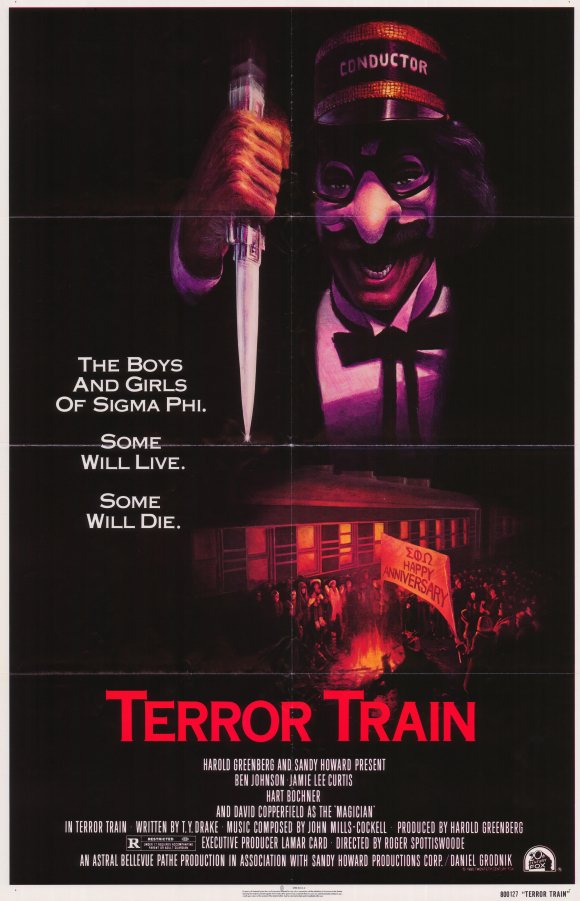Throughout the tax shelter era, Harold Greenberg’s Astral Films was responsible for some of the most divisive Canadian films ever made. With his hand in everything from critically reviled entries like City on Fire (1979) and Death Ship (1980) to the sleazy freak-umentary Being Different (1981) and even the debatable classic In Praise of Older Women (1978), nobody could say Greenberg didn’t know how to provoke an audienceeven if it was usually in the worst way. Produced just a few years before his biggest, and most controversial hit, Porky’s (1982), Terror Train has the distinction of being one of the very first Canadian slasher films ever made, even if it ultimately goes wildly off the rails.
After making her way to Toronto to make Prom Night in the fall of 1979, Jamie Lee Curtis made a brief stop-over in Montreal to reprise her scream queen role in this minor entry in the slasher canon. Terror Train stars Curtis as Alana Maxwell, a graduating med student who is celebrating New Year’s Eve at a costume party on a chartered train. Haunted by a three-year old practical joke that went wrong and drove a fellow classmate insane, Alana and her fraternity friends’ evening of booze and sex is interrupted when they find themselves the target of a killer who adopts the disguises of his victims. While he stalks and slashes his way from car to car, Alana is entertained by a magician (baby-faced David Copperfield), and a kindly conductor (Ben Johnson) tries to keep the bloody massacre under wraps. Has their crazy, pranked pal come back for revenge, or is something more sinister going on?
Despite a high body count and the requisite number of lung-busting howls by Curtis, Terror Train is a fair slasher exercise at best, even when compared to its Canadian contemporaries. Tom Drake’s derivative script, based on American Daniel Grodnik’s equally underdeveloped Halloween-on-a-train concept, just never builds up appropriate steam as it chugs along from one death to the next, frantically trying to maintain viewer interest with a superfluous subplot about romance gone sour, and Copperfield’s increasingly grating sleight-of-hand tricks.
Part of the problem is the intensely unlikable supporting cast, almost entirely populated by Canadian unknowns. Not only did these obnoxious frat boys blindfold and lure their friend Kenny (Derek McKinnon) into bed with a corpse from the school’s morgue, but the audience is thrown into the dreary midst of personal and romantic relationships, as they backstab, cheat and philander their way through the evening. In true tax shelter style, the American stars are given almost all the screen time even when it isn’t warranted by the plot, with screen veteran Johnson running from one end of the train to the other trying to figure out why the bodies keep disappearing. The only interesting role taken by a Canuck is model and future Prince protg Vanity (here billed as D.D. Winters), who is on board as Copperfield’s eye-candy assistant. She would go on to do a second slice of Canadian shlock, battling an ape in Alfred Sole’s Tanya’s Island before leaving for the United States and brief stardom.
Casting aside, though, Terror Train just doesn’t make the cut as a slasher film, consistently squandering its kill-potential with badly paced, by-the-numbers deaths. Sure, the mask switching gimmick may be a good one, as the unknown slasher goes from Groucho Marx to Gill-Man to a creepy crone, but it also prevents the audience from getting close to the only sympathetic character, since they can never really get a handle on his seemingly shifting identity this is especially a problem in the film’s preposterous conclusion. Even still, director Roger Spottiswoode, a former editor who had worked with Sam Peckinpah, should know how to effectively put together a tense murder sequence, but there’s very little suspense or blood in this early effort, possibly due to the inexperience of his own editor, the NFB’s Anne Henderson, who may have been adept at splicing together feminist documentaries, but had never worked beforeor since, mind youon any dramatic feature, never mind a thriller. As a result, the film’s best death, a beheading in the final act, just can’t match the satisfying shock of its immediate Canuck horror predecessor, Prom Night.
Just about the only thing Terror Train has going for it is some interesting camera work and atmosphere-setting set-pieces by Stanley Kubrick’s cinematographer John Alcott. He does a wonderful job capturing the snowy rural Quebec backdropjust about the only truly Canadian aspect of this Halloween wannabewhich occasionally lends the film a feeling of isolated claustrophobia. Unfortunately, this was again outdone a few years later in 1983’s Curtains, a superior Canuxploitation slasher film that clearly took a few cues from this lacklustre tax shelter rip-off.
Though Greenberg’s Astral had a string of horror hits in the 1970s, contributing such genuine Canadian classics as Rituals (1977) and The Little Girl Who Lives Down the Lane (1976), the company was not well equipped to follow in the slasher mold that would dominate the next decade, as Terror Train clearly indicated. With a hefty $4 million price tag, almost double what most Canadian slashers commanded, it has to be considered a failure, both as a competent horror flick and as distinctly Canadian cinema.

